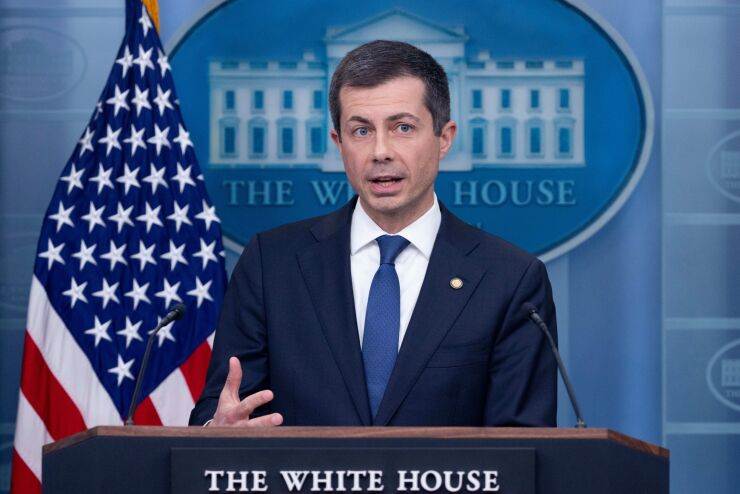The Department of Transportation and Baltimore County have reached an agreement to divert a previously awarded DOT grant to help nearby ports accommodate more cargo following the collapse of the Francis Scott Key Bridge.
That comes along with the announcement Thursday that DOT’s Federal Transit Administration will allocate $20.5 billion to state and local government transit authorities, which includes the $9.9 billion already made available to cover the first five months of the year while Congress was operating under a Continuing Resolution.
The agreement, signed by the DOT and Baltimore County, uses a previously awarded $8.26 million DOT grant to help enable Baltimore County facility Tradepoint Atlantic to accommodate more cargo at Sparrows Point and the Port of Baltimore by expediting paving over 10 acres that will be used for additional cargo laydown area.
Bloomberg News
“In addition to facilitating the movement of roll-on/roll-off and bulk cargo, the increase in laydown area will more than double their prior capacity of 10,000 autos per month to be able to handle over 20,000 autos per month, helping to ensure continued automobile imports and exports in and out of the Port of Baltimore,” the DOT said.
Tradepoint Atlantic has already begun grading work at the Port of Baltimore and expects to be ready to take additional cargo by the end of the month.
“The Biden-Harris Administration has taken quick action finding every way to help Baltimore and the entire region get back on their feet – including last week’s release of $60 million to help Maryland begin urgent work,” said Transportation Secretary Pete Buttigieg in a statement. “We signed a revised grant agreement to allow one of the operators at the Port of Baltimore to use previously awarded federal funds to quickly expand cargo capacity at an area of the port that sits outside of the channel blocked by the collapse of Key Bridge.”
Other DOT agencies have responded with similar urgency. The Federal Highway Administration announced within hours of the request the quick release of $60 million in emergency relief funds for the Maryland DOT to rebuild the bridge, serving as a downpayment for initial costs with more emergency relief expected.
That also comes on top of the Federal Transit Authority completing its transit funding for the remainder of the year, adding over $10 billion to the $9.9 billion already
“Communities depend on this funding to start new transit projects, modernize aging infrastructure and ensure fast, safe, convenient public transportation is available to everyone,” said Veronica Vanterpool, acting administrator for the FTA on a media call Thursday. “This funding will allow agencies nationwide to continue to buy new buses and rail cars, address their repair backlogs, modernize their fleets, and transition to new technologies to address the climate crisis.”
FY 2024 funding levels reflect the U.S. Census Bureau’s new urbanized area boundaries and population figures released in 2022 as part of the Bipartisan Infrastructure Law. Roughly half of the funding will be given out to areas with populations over 200,000.
For the first part of the year covered in the $9.9 billion, $4.8 billion of the formula grants were directed towards urban areas, with the largest tranche, $1.24 billion going to the New York-New Jersey Newark area. The Chicago area saw $341 million, the Los Angeles, Long Beach and Anaheim region received $248 million and the Boston area $203 million.
For the full year appropriations, New York leads the pack with $2.3 billion, with California trailing shortly behind with $2.01 billion. New Jersey will receive $859 million, Illinois $854 million, and Texas, a total of $699 million.
The FTA used transit agencies’ service numbers from 2022, the most recent figures they have reported to the National Transit Database, to calculate apportionments. Some new updated urbanized areas were added at the end of 2023 to reflect 2020 census changes and to account for increases in population.
Among those are Reno, Nevada; Provo and Orem, Utah; Oklahoma City, Oklahoma; Stockton and San Jose, California, Trenton, New Jersey; Charleston, South Carolina; Spokane, Washington and Indianapolis, Indiana, which all saw 15% or more increases in funding compared with 2023 levels.
“FTA will continue to support transit agencies as they rebuild, expand and modernize public transportation in their communities,” Vanterpool said.
